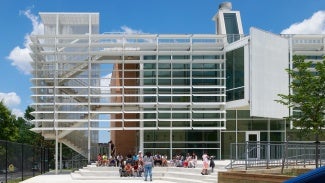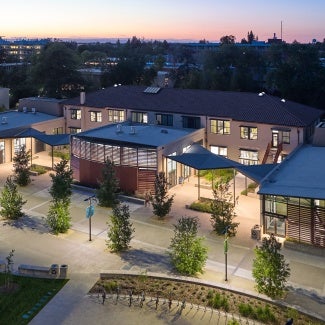Powell Elementary School
The award-winning school design of Powell Elementary School in Washington, D.C. merges old and new to shape a vibrant, green, and healthy learning environment that accommodates the school’s rapidly expanding program.

Project highlights: Powell Elementary School
- Architecture firm: ISTUDIO Architects
- Owner: DC Department of General Services
- Location: Washington
- Category: Excellence
- Project site: Previously developed
- Building program type(s): Education - K-12 school
Merging old and new, the modernization of Washington, D.C.’s Powell Elementary School has shaped a vibrant, green, and healthy learning environment that accommodates the school’s rapidly expanding program. The project combines two new additions and the renovation of a historic brick building through a biophilic approach that bolsters a connection with the cycle of the day and the changing seasons. It also introduces the city to its first-ever solar chimneys.
The project began as a small renovation of the existing historic school, but the team saw a much greater need for the predominantly Latinx school community, which had doubled in size. Fortunately, as the project commenced, President Obama visited the school to raise awareness of the increasing need for quality education. That visit helped the school garner additional funding for two modern additions to accompany the historic building’s renovation.
The two new wings, designed to meet LEED-S Gold standards, add 90,000 square feet to the school’s tight urban site. Their design was guided by four key concepts that contribute to healthy learning environments: outdoor spaces, differentiated learning, daylighting, and fresh air. As a whole, the school is an interactive tool for 21st-century education where engagement with sustainable strategies will encourage a new generation of environmental stewards.
Passive ventilation has been embraced by both students and staff. When the temperature, humidity, and wind speed are right, a green light in each classroom activates, letting the students know to open the windows. As the solar chimneys draw out stale air and replace it with cool air, didactic signage explains the stack effect to students and how they can play their part in environmental stewardship.
The project was planned around two green spaces that offer visual and physical access to the outdoors. Numerous outdoor learning spaces, including natural playgrounds, an outdoor classroom, a green roof, and rooftop curriculum gardens, align with new methodologies in STEM curricula. Exterior stairwells that lead to the outdoor programmatic elements offer students and teachers additional exposure to fresh air between classes.
Spaces inside and outside of the school were designed to accommodate the various ways students learn. The school’s corridors and library feature bay windows with nooks and seating arrangements for small group sessions. Every classroom entrance has bench seating for one-on-one instruction, and the school’s double-height atrium with stadium seating functions as an additional breakout classroom.
The bilingual school not only lifts up its students, but it also welcomes the entire community to its facilities and programming. A critical resource, it draws parents and neighbors to its play spaces and English as a second language classes. To make way for the additions, a beloved community garden was relocated to a hillside across the street, now offering ADA-compliant raised garden beds and stormwater management that prevents erosion.
Framework for Design Excellence measures
Was there a design charrette? Yes
Level of community engagement:
Inform: Potential stakeholders were informed about the project.
Consult: Stakeholders were provided with opportunities to provide input at pre-designed points in the process.
Involve: Stakeholders were involved throughout most of the process.
Collaborate: A partnership is formed with stakeholders to share in the decision-making process including development of alternatives and identification of the preferred solution.
Site area that supported vegetation (landscape or green roof) pre-development: 21%
Site area that supports vegetation post-development: 62%
Site area covered by native plants supporting native or migratory species and pollinators: 62%
Strategies used to promote Design for Ecosystems: Biodiversity, Dark skies, Bird safety, Soil conservation, Habitat conservation, flora/fauna, Abatement of specific regional environmental concerns
Is potable water used for irrigation? No
Is potable water used for cooling? No
Is grey/blackwater reused on-site? No
Is rainwater collected on-site? Yes
Stormwater managed on-site: 76%
2030 Commitment baseline EUI: 58 kBtu/sf/yr
Predicted net EUI including on-site renewables: 37.2 kBtu/sf/yr
Reduction from the benchmark: 21%
Is the project all-electric? No
Level of air filters installed: MERV 12-14
Was a “chemicals of concern” list used to inform material selection? Yes
Do greater than 90% of occupied spaces have a direct view to the outdoors? Yes
Were embodied carbon emissions estimated for this project? Yes
Estimated service life: 200 years
Floor area, if any, representing adapting existing buildings: 46%
Ability to survive without utility power: Partial back-up power
Risk assessment and resilience services provided: Hazard identification, Climate change risk, Building vulnerability assessment, Hazard mitigation strategies above code
Has a post-occupancy evaluation been conducted? Yes
Building performance transparency steps taken:
Present the design, outcomes, and/or lessons learned to the office.
Present the design, outcomes, and/or lessons learned to the profession.
Present the design, outcomes, and/or lessons learned to the public.
Publish post-occupancy data from the project.
Publish lessons learned from design, construction, and/or occupancy.
Project team & jury
Year of substantial project completion: 2018
Gross conditioned floor area: 90,072 sq. ft.
Architect: ISTUDIO Architects
Engineer - Civil: AMT Engineers
Engineer - Structural: Keast + Hood Engineers
Engineer - MEP: Setty & Associates
Engineer - Geotechnical: ECS Capitol Services, PLLC
Consultant - Technology: Educational Systems Planning
Consultant - LEED: Sustainable Design Consulting
Consultant - Acoustics: Hush Acoustics
Consultant - Food Services: FDS Design Studio, LLC
General Contractor: MCN Construction
Lori Cappucio, AIA (Chair), SmithGroup, Washington, DC
Omar Bailey, AIA, Shepley Finch, Phoenix
Vince Gonzales, AIA, Seattle Public Schools, Seattle
Kandis Larsen, AIA, Integrus + YGH, Spokane, Wash.
Sindu Meier, AIA, William Rawn Associates, Milton, Mass.
The Education Facility Design Awards recognize state-of-the-art education environments being developed in today's learning spaces.
Thirteen projects showcase the best in today's learning spaces.










